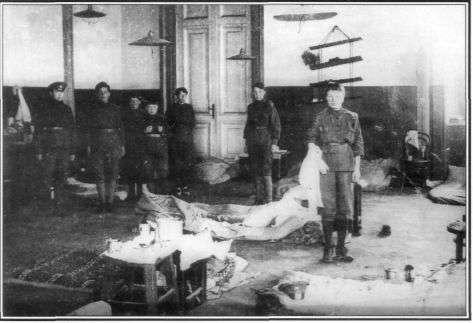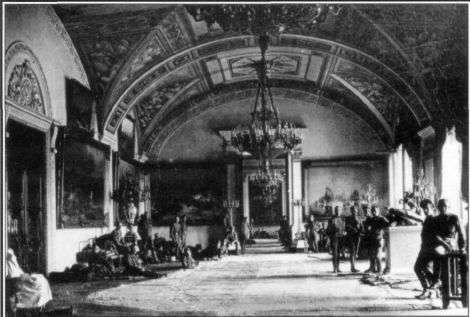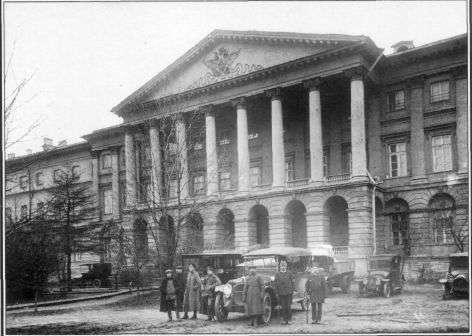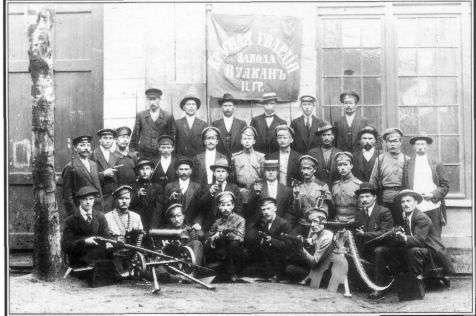A People's Tragedy (101 page)
Read A People's Tragedy Online
Authors: Orlando Figes

60 General Kornilov is greeted as a hero by the right-wing members of the Officers'
Union on his arrival in Moscow for the State Conference on 12 August.


61 Members of the Women's Battalion of Death await the final assault on the Winter Palaee, 25 Oetober 1917. When the
Aurora
fired its first salvo the women became hysterical and had to be confined in a basement room.
62 More of Kerensky's last defenders, barricaded inside the Winter Palace, await the assault of the Bolshevik forces on 25 October.


63 The Smolny Institute, seat of the Soviet and command centre of the Bolshevik Party, in early October.
64 The Red Guard of the Vulkan Factory in Petrograd. Note the ties and suits of many of the guards.
bones. On the streets adjacent to the Nikolaevsky Station groups of engineers huddled, shivering from the cold, and peered vigilantly into the shadowy night. The moonlight created a fantastic scene. The hulks of the houses looked like medieval castles, and giant shadows followed the engineers. At this sight the next-to-last Emperor appeared to rein in his horse in horror.11
These early successes strengthened Lenin's appeal for the immediate seizure of power.
The Bolshevik leaders did not want a repeat of the July Days, when their own initial hesitation in supporting the initiative of the streets had resulted in fiasco. As news reached them of the Bolshevik gains, so pressure mounted to take control of the situation and start the insurrection. Lenin's intervention was decisive. Confined to Fofanova's flat, he had become increasingly frustrated as he watched the day's events unfold. At 6 p.m. he scribbled a desperate appeal to the Petrograd party organizations, urging them to launch an insurrection in the next few hours, and ordered Fofanova to deliver it to the Smolny. The Soviet Congress was due to open the following afternoon, and unless the Bolsheviks had already seized power by then, his whole political strategy would be doomed. By 10 p.m. Lenin could hold back no longer. He donned his wig and a worker's cap, wrapped a bandage around his head, and set off for the Smolny, accompanied by the Finnish Bolshevik, Eino Rakhia. Riding through the Vyborg district in an empty streetcar, Lenin overwhelmed the poor conductress with questions on the latest situation and, discovering that she was a leftist, bullied her with advice on revolutionary action. From the Finland Station the two men continued their journey on foot. Near the Tauride Palace a government patrol stopped them, but, according to Rakhia, mistook Lenin, who was dressed in his worst clothes, for a harmless drunk and let them proceed.12 One can only wonder how different history would have been if Lenin had been arrested.
Shortly before midnight they finally reached the Smolny. The building was ablaze with lights, like an ocean liner in the dark night sea. Trucks and armoured cars rushed to and fro laden down with Bolshevik troops and guns. Machine-guns had been set up outside the gates, where the Red Guards huddled around a bonfire checking the passes of those wanting to enter the military headquarters of the insurrection. Lenin had arrived without a pass and, in his disguise, was not recognized by the Red Guards; he only succeeded in gaining entry by squeezing through them amidst a crowd. He went at once to Room 36, where the Bolshevik caucus met, and harangued his comrades on the need to start the seizure of power. A meeting of the Central Committee was hastily convened and, although no protocol of it was recorded, the testimonies of those who were there are all agreed that Lenin had a decisive effect in changing the
dominant mood from one of defence to one of offence. The Central Committee at last gave the order for the insurrection to begin. A map of the city was brought out and the Bolshevik leaders pored over it, drawing up the main lines
of attack and assigning military tasks.
During a break in their deliberations Lenin suggested drawing up a list of the Bolshevik government to be presented to the Soviet Congress the next day. The question arose as to what to call the new government and its members. The term 'Provisional Government' was thought to sound outmoded, whilst calling themselves 'ministers'
seemed far too bureaucratic and respectable. The Bolsheviks, after all, liked to see themselves as a fighting organization: they dressed in macho black leather jackets and military boots, whereas most of the other political parties wore ministerial suits.* It was Trotsky who came forward with the idea of calling the ministers 'people's commissars'
in emulation of the Jacobins. Everyone liked the suggestion. 'Yes, that's very good,' said Lenin, 'it smells of revolution. And we can call the government itself the "Council of People's Commissars".' Nominations were taken for the various cabinet posts, although with Kerensky not yet overthrown the exercise seemed rather premature and was carried out in a light-hearted manner. Lenin stretched himself out on the floor, relaxed and triumphant. He made several jokes at Kamenev's expense, who had warned that the party could not hold on to power for more than a fortnight. 'Never mind,' Lenin quipped,
'when, in two years' time, we are still in power, then you will be saying that we cannot survive longer than two years.'13
*** Few historical events have been more profoundly distorted by myth than those of 25 October 1917. The popular image of the Bolshevik insurrection, as a bloody struggle by the tens of thousands with several thousand fallen heroes, owes more to
October
—
Eisenstein's brilliant but largely fictional propaganda film to commemorate the tenth anniversary of the event — than to historical fact. The Great October Socialist Revolution, as it came to be called in Soviet mythology, was in reality such a small-scale event, being in effect no more than a military coup, that it passed unnoticed by the vast majority of the inhabitants of Petrograd. Theatres, restaurants and tram cars functioned much as normal while the Bolsheviks came to power. The whole insurrection could have been completed in six hours, had it not been for the ludicrous incompetence of the insurgents themselves, which made it take an extra fifteen. The legendary 'storming' of the Winter Palace, where Kerensky's cabinet held its final session, was more like a routine house arrest, since most of the forces defending the palace had already left for home, hungry and dejected, before the assault began. The
* It was only under Stalin, when the Bolsheviks began to call themselves 'Ministers', that they reverted back to suits.
only real damage to the imperial residence in the whole affair was a chipped cornice and a shattered window on the third floor.
The Bolshevik plan was simple: the garrison soldiers, the Red Guards and the Kronstadt sailors were to capture the Marinsky Palace and disperse the Preparliament; demand the surrender of the Provisional Government and, if it refused, seize control of the Winter Palace on a signal from the Peter and Paul Fortress and the Baltic cruiser
Aurora.
The MRC expected to complete the operations by noon — in time for Lenin to present the seizure of power as a
fait accompli
to the Soviet Congress. At 10 a.m., in anticipation of a speedy victory, the Bolshevik leader was already putting the final touches to his manifesto, 'To the Citizens of Russia!', announcing the overthrow of the Provisional Government and the transfer of power to the MRC.14
The first part of the plan went smoothly enough: shortly before noon a group of Bolshevik soldiers and sailors burst into the Marinsky Palace and ordered the deputies to disperse. But after that elementary technical failures forced the MRC to postpone the operations around the Winter Palace until 3 p.m., then 6 p.m., whereafter it ceased to bother with any set deadlines at all. The first major hold-up was the late arrival of the Baltic sailors, without whom the MRC would not go ahead. Then there was another, even more frustrating, problem. The assault on the Winter Palace was due to begin with the heavy field-guns of the Peter and Paul Fortress, but at the final moment these were discovered to be rusty museum pieces which could not be fired. Soldiers were hastily sent out to drag alternative cannons up to the fortress walls, but when these arrived it turned out that there were no suitable shells for them. Even more surreal was the panic created by the seemingly simple task of raising a red lantern to the top of the fortress's flagpole to signal the start of the assault on the palace. When the moment for action arrived, no red lantern could be found. The Bolshevik Commissar of the Fortress, Blagonravov, went out in search of a suitable lamp but got himself lost in the dark and fell into a muddy bog. When he finally returned, the lamp he had brought could not be fixed to the flagpole and was never seen by those who took part in the assault. In any case, it wasn't red.15
From Lenin's point of view all these delays were infuriating. It was vital for him to have the seizure of power completed before the opening of the Soviet Congress and, although this too had been delayed, time was rapidly running out. At around 3 p.m. he had told a packed session of the Petrograd Soviet that the Provisional Government had already been overthrown. It was of course a lie — the Ministers were still barricaded inside the Winter Palace — but that was a minor detail: the fact of the seizure of power was to be so important to his political strategy over the next few hours that he was even prepared to invent it. As afternoon turned into evening, he screamed at the MRC commanders to seize the Winter Palace without delay. Podvoisky recalls him pacing around in a small room in the Smolny 'like a lion in a cage. He needed the Winter Palace at any cost... he was ready to shoot us.'16
In fact the Bolshevik forces which had gathered in the centre of the city by this stage could have walked quite freely into the Winter Palace, since its defence was almost non-existent. With the mutiny of the Petrograd garrison, Kerensky had tried to summon loyal troops from the Northern Front. His order had been dispatched on the night of the 24th with the forged signature of the Soviet leaders, since Kerensky feared the soldiers would not come on the authority of the Provisional Government. By the following morning there was still no sign of the troops and he resolved to go off in search of them.
With the railways in Bolshevik hands, he was forced to travel by car; but such was the utter helplessness of the Provisional Government that it did not even have a taxi at its disposal. Military officials were sent out to find a car. They seized a Renault from outside the American Embassy (which later launched a diplomatic protest), while a second car was found at the War Ministry, although it had no fuel and more men had to be sent out to 'borrow' some from the English Hospital. At around 11 a.m. the two cars sped out of the Winter Palace and headed out of the city. Kerensky was seated in the second car, flying the Stars and Stripes, which no doubt helped him past the MRC
